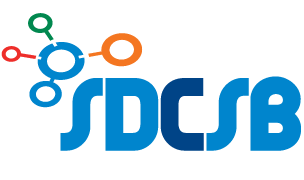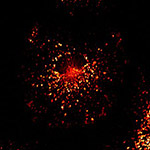Genetics, Bioinformatics and Systems Biology Colloquium
Thursdays, 12:00 pm – 1:00 pm
UC San Diego, Powell-Focht Bioengineering Hall, Fung Auditorium
Complete schedule here
Investigators: Gurol Suel, Roy Wollman
Understanding the emergent properties of tissue-level organization is a fundamental problem in biology. These properties emerge from the many different interactions of individual cells within a tissue. Yet, there are no methods that use the spatial distribution of cells and their signaling state to build a computational model that can make specific, testable predictions on tissue-level phenotypes. In this project we will use the maps-to-models paradigm to study two models of biological tissue organization: (1) antibiotic resistance of a biofilm of Bacillus subtilis; and (2) induction of viral protection through type I interferon response in lung epithelial cells during influenza infection. Through the use of two separate model systems we will demonstrate the utility of our approach and show how it could be further adapted to the analysis of tissue-level biological organization.
A key benefit of the Maps-to-Models paradigm is the generation of two interdependent deliverables: (1) a map depicting interactions (edges) between building blocks (node); and (2) a computational model generating testable predictions on the functional output of the network. In this project, the basic biological unit is the cell. We will generate detailed, quantitative network maps characterizing heterogeneous cells within a tissue and their communication network. Cells states will be determined by analyzing the signaling states of each individual cell. The interaction network between individual cells depends on their strength of paracrine communication. An edge will connect any two sender and receiver cells within the tissue and the weight of the edge will denote the strength of the diffusion limited communication. The two maps generated by this project will provide information on the spatiotemporal organization of bacillus biofilms and epithelium barriers and the extent of cell-to-cell communication within these tissues. These maps will be used to develop quantitative, predictive models.
| One part of this project will focus on the emergence of antibiotic resistance during biofilm formation of B. subtilis strain NCIB-3610. Numerous genes involved in biofilm formation have been identified in this strain, and, as a result, much of our understanding of biofilm formation was obtained in this model system. Despite this wealth of information, many fundamental questions remain unaddressed. The Suel laboratory has developed extensive expertise in quantitative measurements and genetic manipulation of NCIB-3610 (Asally et al., Proc Natl Acad Sci U S A 2012) including the use of multicolor fluorescence microscopy to simultaneously measure the activities of multiple intracellular processers in individual cells (Cagatay et al., Cell 2009. Fluorescent proteins and reporter dyes with distinct spectral will be used to track specific molecules and reactions in B. subtilis. These fluorescent reagents will be tracked using our fully automated, multicolor fluorescence time-lapse microscopy systems, which also provide temperature, humidity and gas control. Having tested many microscope objectives, we have identified special long distance objectives that are capable of measuring biofilms over a centimeter in diameter. We have also developed custom software, which can quantify microscopy images to track cell lineages or other movements within biofilms. |
|
| The second part of this project will focus on the epithelium, a critical barrier that protects our bodies from infections by harmful pathogens. Communication between cells within the epithelium is important for initiating and managing innate immune responses. It is not clear though how the epithelium balances generating enough of an immune response to combat the pathogen while not damaging itself. One possible mechanism is that individual cellular responses are stochastic and might thus determine the extent of cell-to-cell communication. Previously, the Wollman laboratory explored the role of stochastic cellular responses during NF-κB signaling in response to LPS (Selimkhanov et al., Science 2014). In the course of this work, we developed a suite of computational tools capable of automatically analyzing fluorescent microscopy images for nuclear and cytoplasmic levels of p65, a subunit of NF-κB subunit. In this project, we will continue to study this pathway, using p65 translocation as readout of cellular response to viral infection. |
|
Recent Publications by these New SDCSB Investigators:
- Chiou, JG, Chou, TK, Garcia-Ojalvo, J, Süel, GM. Intrinsically robust and scalable biofilm segmentation under diverse physical growth conditions. iScience. 2024;27 (12):111386. doi: 10.1016/j.isci.2024.111386. PubMed PMID:39669429 PubMed Central PMC11635021.
- Moon, EC, Modi, T, Lee, DD, Yangaliev, D, Garcia-Ojalvo, J, Ozkan, SB et al.. Physiological cost of antibiotic resistance: Insights from a ribosome variant in bacteria. Sci Adv. 2024;10 (46):eadq5249. doi: 10.1126/sciadv.adq5249. PubMed PMID:39546593 PubMed Central PMC11567004.
- Hemminger, Z, Sanchez-Tam, G, Ocampo, H, Wang, A, Underwood, T, Xie, F et al.. Spatial Single-Cell Mapping of Transcriptional Differences Across Genetic Backgrounds in Mouse Brains. bioRxiv. 2024; :. doi: 10.1101/2024.10.08.617260. PubMed PMID:39416191 PubMed Central PMC11483037.
- Kikuchi, K, Galera-Laporta, L, Weatherwax, C, Lam, JY, Moon, EC, Theodorakis, EA et al.. Electrochemical potential enables dormant spores to integrate environmental signals. Science. 2022;378 (6615):43-49. doi: 10.1126/science.abl7484. PubMed PMID:36201591 PubMed Central PMC10593254.
- Maltz, E, Wollman, R. Quantifying the phenotypic information in mRNA abundance. Mol Syst Biol. 2022;18 (8):e11001. doi: 10.15252/msb.202211001. PubMed PMID:35965452 PubMed Central PMC9376724.
- Comerci, CJ, Gillman, AL, Galera-Laporta, L, Gutierrez, E, Groisman, A, Larkin, JW et al.. Localized electrical stimulation triggers cell-type-specific proliferation in biofilms. Cell Syst. 2022;13 (6):488-498.e4. doi: 10.1016/j.cels.2022.04.001. PubMed PMID:35512710 PubMed Central PMC9233089.
- Lannan, R, Maity, A, Wollman, R. Epigenetic fluctuations underlie gene expression timescales and variability. Physiol Genomics. 2022;54 (6):220-229. doi: 10.1152/physiolgenomics.00051.2021. PubMed PMID:35476585 .
- Chou, KT, Lee, DD, Chiou, JG, Galera-Laporta, L, Ly, S, Garcia-Ojalvo, J et al.. A segmentation clock patterns cellular differentiation in a bacterial biofilm. Cell. 2022;185 (1):145-157.e13. doi: 10.1016/j.cell.2021.12.001. PubMed PMID:34995513 PubMed Central PMC8754390.
- Galera-Laporta, L, Comerci, CJ, Garcia-Ojalvo, J, Süel, GM. IonoBiology: The functional dynamics of the intracellular metallome, with lessons from bacteria. Cell Syst. 2021;12 (6):497-508. doi: 10.1016/j.cels.2021.04.011. PubMed PMID:34139162 PubMed Central PMC8570674.
- Littman, R, Hemminger, Z, Foreman, R, Arneson, D, Zhang, G, Gómez-Pinilla, F et al.. Joint cell segmentation and cell type annotation for spatial transcriptomics. Mol Syst Biol. 2021;17 (6):e10108. doi: 10.15252/msb.202010108. PubMed PMID:34057817 PubMed Central PMC8166214.













